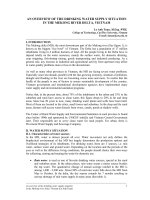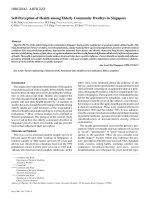Tài liệu Numerical Solution of Stochastic Differential Equations with Jumps in Finance pdf
Bạn đang xem bản rút gọn của tài liệu. Xem và tải ngay bản đầy đủ của tài liệu tại đây (17.02 MB, 868 trang )
Stochastic Mechanics
Random Media
Signal Processing
and Image Synthesis
Mathematical Economics and Finance
Stochastic Optimization
Stochastic Control
Stochastic Models in Life Sciences
Stochastic Modelling
and Applied Probability
(Formerly:
Applications of Mathematics)
64
Edited by B. Rozovski
˘
ı
G. Grimmett
Advisory Board M. Hairer
I. Karatzas
F.P. Kelly
A. Kyprianou
Y. L e J a n
B. Øksendal
G. Papanicolaou
E. Pardoux
E. Perkins
For other titles in this series, go to
/>Eckhard Platen
r
Nicola Bruti-Liberati
Numerical Solution
of Stochastic
Differential Equations
with Jumps in Finance
Eckhard Platen
Nicola Bruti-Liberati (1975–2007)
School of Finance and Economics
Department of Mathematical Sciences
University of Technology, Sydney
PO Box 123
Broadway NSW 2007
Australia
Managing Editors
Boris Rozovski
˘
ı
Division of Applied Mathematics
Brown University
182 George St
Providence, RI 02912
USA
Geoffrey Grimmett
Centre for Mathematical Sciences
University of Cambridge
Wilberforce Road
Cambridge CB3 0WB
UK
ISSN 0172-4568
ISBN 978-3-642-12057-2
e-ISBN 978-3-642-13694-8
DOI 10.1007/978-3-642-13694-8
Springer Heidelberg Dordrecht London New York
Library of Congress Control Number: 2010931518
Mathematics Subject Classification (2010): 60H10, 65C05, 62P05
© Springer-Verlag Berlin Heidelberg 2010
This work is subject to copyright. All rights are reserved, whether the whole or part of the material is
concerned, specifically the rights of translation, reprinting, reuse of illustrations, recitation, broadcasting,
reproduction on microfilm or in any other way, and storage in data banks. Duplication of this publication
or parts thereof is permitted only under the provisions of the German Copyright Law of September 9,
1965, in its current version, and permission for use must always be obtained from Springer. Violations are
liable to prosecution under the German Copyright Law.
The use of general descriptive names, registered names, trademarks, etc. in this publication does not imply,
even in the absence of a specific statement, that such names are exempt from the relevant protective laws
and regulations and therefore free for general use.
Cover design: deblik
Printed on acid-free paper
Springer is part of Springer Science+Business Media (www.springer.com)
Preface
This research monograph concerns the design and analysis of discrete-time
approximations for stochastic differential equations (SDEs) driven by Wiener
processes and Poisson processes or Poisson jump measures. In financial and
actuarial modeling and other areas of application, such jump diffusions are
often used to describe the dynamics of various state variables. In finance these
may represent, for instance, asset prices, credit ratings, stock indices, interest
rates, exchange rates or commodity prices. The jump component can capture
event-driven uncertainties, such as corporate defaults, operational failures or
insured events. The book focuses on efficient and numerically stable strong
and weak discrete-time approximations of solutions of SDEs. Strong approx-
imations provide efficient tools for simulation problems such as those arising
in filtering, scenario analysis and hedge simulation. Weak approximations, on
the other hand, are useful for handling problems via Monte Carlo simulation
such as the evaluation of moments, derivative pricing, and the computation of
risk measures and expected utilities. The discrete-time approximations con-
sidered are divided into regular and jump-adapted schemes. Regular schemes
employ time discretizations that do not include the jump times of the Poisson
jump measure. Jump-adapted time discretizations, on the other hand, include
these jump times.
The first part of the book provides a theoretical basis for working with
SDEs and stochastic processes with jumps motivated by applications in fi-
nance. This part also introduces stochastic expansions for jump diffusions.
It further proves powerful results on moment estimates of multiple stochas-
tic integrals. The second part presents strong discrete-time approximations
of SDEs with given strong order of convergence, including derivative-free and
predictor-corrector schemes. The strong convergence of higher order schemes
for pure jump SDEs is established under conditions weaker than those required
for jump diffusions. Estimation and filtering methods are discussed. The third
part of the book introduces a range of weak approximations with jumps.
These weak approximations include derivative-free, predictor-corrector, and
VI Preface
simplified schemes. The final part of the research monograph raises questions
on numerical stability and discusses powerful martingale representations and
variance reduction techniques in the context of derivative pricing.
The book does not claim to be a complete account of the state of the
art of the subject. Rather it attempts to provide a systematic framework for
an understanding of the basic concepts and tools needed when implement-
ing simulation methods for the numerical solution of SDEs. In doing so the
book aims to follow up on the presentation of the topic in Kloeden & Platen
(1999) where no jumps were considered and no particular field of applica-
tion motivated the numerical methods. The book goes significantly beyond
Kloeden & Platen (1999). It is covering many new results for the approxi-
mation of continuous solutions of SDEs. The discrete time approximation of
SDEs with jumps represents the focus of the monograph. The reader learns
about powerful numerical methods for the solution of SDEs with jumps. These
need to be implemented with care. It is directed at readers from different fields
and backgrounds.
The area of finance has been chosen to motivate the methods. It has been
also a focus of research by the first author for many years that culminated
in the development of the benchmark approach, see Platen & Heath (2006),
which provides a general framework for modeling risk in finance, insurance and
other areas and may be new to most readers. The book is written at a level
that is appropriate for a reader with an engineer’s or similar undergraduate
training in mathematical methods. It is readily accessible to many who only
require numerical recipes.
Together with Nicola Bruti-Liberati we had for several years planned a
book to follow on the book with Peter Kloeden on the “Numerical Solution of
Stochastic Differential Equations”, which first appeared in 1992 at Springer
Verlag and helped to develop the theory and practice of this field. Nicola’s
PhD thesis was written to provide proofs for parts of such a book. It is very
sad that Nicola died tragically in a traffic accident on 28 August 2007. This
was an enormous loss for his family and friends, his colleagues and the area
of quantitative methods in finance.
The writing of such a book was not yet started at the time of Nicola’s
tragic death. I wish to express my deep gratitude to Katrin Platen, who
then agreed to typeset an even more comprehensive book than was originally
envisaged. She carefully and patiently wrote and revised several versions of
the manuscript under difficult circumstances. The book now contains not only
results that we obtained with Nicola on the numerical solution of SDEs with
jumps, but also presents methods for exact simulation, parameter estimation,
filtering and efficient variance reduction, as well as the simulation of hedge
ratios and the construction of martingale representations.
I would like to thank several colleagues for their collaboration in related
research and valuable suggestions on the manuscript, including Kevin Bur-
rage, Leunglung Chan, Kristoffer Glover, David Heath, Des Higham, Hardy
Hulley, Constantinos Kardaras, Peter Kloeden, Uwe K¨uchler, Herman Lukito,
Preface VII
Remigius Mikulevicius, Renata Rendek, Wolfgang Runggaldier, Lei Shi and
Anthony Tooman. Particular thanks go to Rob Lynch, the former Dean of
the Faculty of Business at the University of Technology Sydney, who made
the writing of the book possible through his direct support. Finally, I like to
thank the Editor, Catriona Byrne, at Springer for her excellent work and her
encouragement to write this book as a sequel of the previous book with Peter
Kloeden.
It is greatly appreciated if readers could forward any errors, misprints
or suggested improvements to: The interested
reader is likely to find updated information about the numerical solution
of stochastic differential equations on the webpage of the first author under
“Numerical
Methods”:
/>finance/staff/Eckhard/Numerical
Methods.html
Sydney, January 2010 Eckhard Platen
Contents
Preface V
Suggestions for the Reader XV
Basic Notation XIX
Motivation and Brief Survey XXIII
1 Stochastic Differential Equations with Jumps 1
1.1 StochasticProcesses 1
1.2 Supermartingales and Martingales . . 16
1.3 QuadraticVariationandCovariation 23
1.4 ItˆoIntegral 26
1.5 ItˆoFormula 34
1.6 StochasticDifferentialEquations 38
1.7 LinearSDEs 45
1.8 SDEswithJumps 53
1.9 ExistenceandUniquenessofSolutionsofSDEs 57
1.10 Exercises . . . . . 59
2 Exact Simulation of Solutions of SDEs 61
2.1 MotivationofExactSimulation 61
2.2 SamplingfromTransitionDistributions 63
2.3 ExactSolutionsofMulti-dimensionalSDEs 78
2.4 FunctionsofExactSolutions 99
2.5 AlmostExactSolutionsby Conditioning 105
2.6 AlmostExactSimulation byTimeChange 113
2.7 FunctionalsofSolutionsofSDEs 123
2.8 Exercises 136
X Contents
3 Benchmark Approach to Finance and Insurance 139
3.1 MarketModel 139
3.2 Best Performing Portfolio . . 142
3.3 Supermartingale Property and Pricing . . 145
3.4 Diversification 149
3.5 RealWorldPricingUnderSomeModels 158
3.6 RealWorldPricingUndertheMMM 168
3.7 BinomialOptionPricing 176
3.8 Exercises 185
4 Stochastic Expansions 187
4.1 IntroductiontoWagner-PlatenExpansions 187
4.2 MultipleStochasticIntegrals 195
4.3 CoefficientFunctions 202
4.4 Wagner-PlatenExpansions 206
4.5 Momentsof Multiple StochasticIntegrals 211
4.6 Exercises 230
5 Introduction to Scenario Simulation 233
5.1 ApproximatingSolutions of ODEs 233
5.2 ScenarioSimulation 245
5.3 StrongTaylorSchemes 252
5.4 Derivative-FreeStrongSchemes 266
5.5 Exercises 271
6 Regular Strong Taylor Approximations with Jumps 273
6.1 Discrete-TimeApproximation 273
6.2 StrongOrder1.0Taylor Scheme 278
6.3 CommutativityConditions 286
6.4 ConvergenceResults 289
6.5 Lemma on Multiple Itˆo Integrals 292
6.6 ProofoftheConvergenceTheorem 302
6.7 Exercises 307
7 Regular Strong Itˆo Approximations 309
7.1 ExplicitRegularStrongSchemes 309
7.2 Drift-ImplicitSchemes 316
7.3 Balanced Implicit Methods . 321
7.4 Predictor-CorrectorSchemes 326
7.5 ConvergenceResults 331
7.6 Exercises 346
Contents XI
8 Jump-Adapted Strong Approximations 347
8.1 IntroductiontoJump-AdaptedApproximations 347
8.2 Jump-AdaptedStrongTaylorSchemes 350
8.3 Jump-AdaptedDerivative-Free Strong Schemes 355
8.4 Jump-AdaptedDrift-ImplicitSchemes 356
8.5 Predictor-CorrectorStrongSchemes 359
8.6 Jump-AdaptedExactSimulation 361
8.7 ConvergenceResults 362
8.8 NumericalResultsonStrongSchemes 368
8.9 Approximationof Pure Jump Processes 375
8.10 Exercises . . . . . 388
9 Estimating Discretely Observed Diffusions 389
9.1 MaximumLikelihoodEstimation 389
9.2 DiscretizationofEstimators 393
9.3 TransformFunctionsforDiffusions 397
9.4 EstimationofAffineDiffusions 404
9.5 AsymptoticsofEstimatingFunctions 409
9.6 EstimatingJumpDiffusions 413
9.7 Exercises 417
10 Filtering 419
10.1 Kalman-Bucy Filter . . . 419
10.2 Hidden Markov Chain Filters . . . . . . 424
10.3 Filtering a Mean Reverting Process . 433
10.4 Balanced Method in Filtering . . . . . . 447
10.5 A Benchmark Approach to Filtering in Finance . . 456
10.6 Exercises . . . . . 475
11 Monte Carlo Simulation of SDEs 477
11.1 Introduction to Monte Carlo Simulation . 477
11.2 Weak Taylor Schemes . . 481
11.3 Derivative-Free Weak Approximations . . . 491
11.4 Extrapolation Methods . 495
11.5 Implicit and Predictor-Corrector Methods . . . 497
11.6 Exercises . . . . . 504
12 Regular Weak Taylor Approximations 507
12.1 Weak Taylor Schemes . . 507
12.2 Commutativity Conditions. . 514
12.3 Convergence Results . . . 517
12.4 Exercises . . . . . 522
XII Contents
13 Jump-Adapted Weak Approximations 523
13.1 Jump-Adapted Weak Schemes . . . . . 523
13.2 Derivative-Free Schemes 529
13.3 Predictor-Corrector Schemes 530
13.4 Some Jump-Adapted Exact Weak Schemes . . 533
13.5 Convergence of Jump-Adapted Weak Taylor Schemes . 534
13.6 Convergence of Jump-Adapted Weak Schemes . . . . 543
13.7 Numerical Results on Weak Schemes 548
13.8 Exercises . . . . . 569
14 Numerical Stability 571
14.1 Asymptotic p-Stability . 571
14.2 Stability of Predictor-Corrector Methods 576
14.3 Stability of Some Implicit Methods . 583
14.4 Stability of Simplified Schemes . . . . . 586
14.5 Exercises . . . . . 590
15 Martingale Representations and Hedge Ratios 591
15.1 General Contingent Claim Pricing . . 591
15.2 Hedge Ratios for One-dimensional Processes . 595
15.3 Explicit Hedge Ratios . . 601
15.4 Martingale Representation for Non-Smooth Payoffs . . . 606
15.5 Absolutely Continuous Payoff Functions . 616
15.6 Maximum of Several Assets . 621
15.7 Hedge Ratios for Lookback Options 627
15.8 Exercises . . . . . 635
16 Variance Reduction Techniques 637
16.1 Various Variance Reduction Methods . . . 637
16.2 Measure Transformation Techniques 645
16.3 Discrete-Time Variance Reduced Estimators . 658
16.4 Control Variates . . . 669
16.5 HP Variance Reduction 677
16.6 Exercises . . . . . 694
17 Trees and Markov Chain Approximations 697
17.1 Numerical Effects of Tree Methods . 697
17.2 Efficiency of Simplified Schemes . . . . 712
17.3 Higher Order Markov Chain Approximations 720
17.4 Finite Difference Methods . . 734
17.5 Convergence Theorem for Markov Chains 744
17.6 Exercises . . . . . 753
18 Solutions for Exercises 755
Acknowledgements 781
Contents XIII
Bibliographical Notes 783
References 793
Author Index 835
Index 847
Suggestions for the Reader
It has been mentioned in the Preface that the material of this book has been
arranged in a way that should make it accessible to as wide a readership as
possible. Prospective readers will have different backgrounds and objectives.
The following four groups are suggestions to help use the book more efficiently.
(i) Let us begin with those readers who aim for a sufficient understanding,
to be able to apply stochastic differential equations with jumps and ap-
propriate simulation methods in their field of application, which may not
be finance. Deeper mathematical issues are avoided in the following sug-
gested sequence of reading, which provides a guide to the book for those
without a strong mathematical background:
§1.1 →§1.2 →§1.3 →§1.4 →§1.5 →§1.6 →§1.7 →§1.8
↓
§5.1 →§5.2 →§5.3 →§5.4
↓
§6.1 →§6.2 →§6.3
↓
§7.1 →§7.2 →§7.3 →§7.4
↓
§8.1 →§8.2 →§8.3 →§8.4 →§8.5 →§8.6 →§8.8
↓
§11.1 →§11.2 →§11.3 →§11.4 →§11.5
↓
§12.1 →§12.2
↓
§13.1 →§13.2 →§13.3 →§13.4 →§13.7
↓
Chapter 14
↓
§16.1
XVI Suggestions for the Reader
(ii) Engineers, quantitative analysts and others with a more technical back-
ground in mathematical and quantitative methods who are interested in
applying stochastic differential equations with jumps, and in implement-
ing efficient simulation methods or developing new schemes could use the
book according to the following suggested flowchart. Without too much
emphasis on proofs the selected material provides the underlying mathe-
matics.
Chapter 1
↓
Chapter 2
↓
Chapter 4
↓
Chapter 5
↓
§6.1 →§6.2 →§6.3
↓
§7.1 →§7.2 →§7.3 →§7.4
↓
§8.1 →§8.2 →§8.3 →§8.4 →§8.5 →§8.6 →§8.8 →§8.9
↓
Chapter 11
↓
§12.1 →§12.2
↓
§13.1 →§13.2 →§13.3 →§13.4 →§13.7
↓
Chapter 14
↓
Chapter 16
Suggestions for the Reader XVII
(iii) Readers with strong mathematical background and mathematicians may
omit the introductory Chap.1. The following flowchart focuses on the the-
oretical aspects of the numerical approximation of solutions of stochastic
differential equations with jumps while avoiding well-known or applied
topics.
Chapter 2
↓
Chapter 4
↓
Chapter 5
↓
Chapter 6
↓
Chapter 7
↓
Chapter 8
↓
Chapter 11
↓
Chapter 12
↓
Chapter 13
↓
Chapter 14
↓
Chapter 16
XVIII Suggestions for the Reader
(iv) Financial engineers, quantitative analysts, risk managers, fund managers,
insurance professionals and others who have no strong mathematical back-
ground and are interested in finance, insurance and other areas of risk
management will find the following flowchart helpful. It suggests the read-
ing for an introduction into quantitative methods in finance and related
areas.
§1.1 →§1.2 →§1.3 →§1.4 →§1.5 →§1.6 →§1.7 →§1.8
↓
Chapter 2
↓
Chapter 3
↓
Chapter 5
↓
§6.1 →§6.2 →§6.3
↓
§7.1 →§7.2 →§7.3 →§7.4
↓
§8.1 →§8.2 →§8.3 →§8.4 →§8.5 →§8.6 →§8.8
↓
Chapter 9
↓
Chapter 10
↓
Chapter 11
↓
§12.1 →§12.2
↓
§13.1 →§13.2 →§13.3 →§13.4 →§13.7
↓
Chapter 14
↓
Chapter 15
↓
Chapter 16
↓
Chapter 17
Basic Notation
μ
X
mean of X
σ
2
X
,Var(X) variance of X
Cov(X, Y ) covariance of X and Y
inf{·} greatest lower bound
sup{·} smallest upper bound
max(a, b)=a ∨ b maximum of a and b
min(a, b)=a ∧ b minimum of a and b
(a)
+
=max(a, 0) maximum of a and 0
x
transpose of a vector or matrix x
x =(x
1
,x
2
, ,x
d
)
column vector x ∈
d
with ith component x
i
|x| absolute value of x or Euclidean norm
A =[a
i,j
]
k,d
i,j=1
(k ×d)-matrix A with ijth component a
i,j
det (A) determinant of a matrix A
A
−1
inverse of a matrix A
(x, y) inner product of vectors x and y
N = {1, 2, } set of natural numbers
XX Basic Notation
∞ infinity
(a, b) open interval a<x<bin
[a, b] closed interval a ≤ x ≤ b in
=(−∞, ∞) set of real numbers
+
=[0, ∞) set of nonnegative real numbers
d
d-dimensional Euclidean space
Ω sample space
∅ empty set
A ∪ B the union of sets A and B
A ∩ B the intersection of sets A and B
A\B the set A without the elements of B
E = \{0}without origin
[X, Y ]
t
covariation of processes X and Y at time t
[X]
t
quadratic variation of process X at time t
n!=1·2 · · n factorial of n
[a] largest integer not exceeding a ∈
i.i.d. independent identically distributed
a.s. almost surely
f
first derivative of f : →
f
second derivative of f : →
f : Q
1
→ Q
2
function f from Q
1
into Q
2
∂u
∂x
i
ith partial derivative of u :
d
→
∂
∂x
i
k
ukth order partial derivative of u with respect to x
i
∃ there exists
F
X
(·) distribution function of X
f
X
(·) probability density function of X
φ
X
(·) characteristic function of X
1
A
indicator function for event A to be true
Basic Notation XXI
N(·) Gaussian distribution function
Γ (·) gamma function
Γ (·; ·) incomplete gamma function
(mod c) modulo c
A collection of events, sigma-algebra
A
filtration
E(X) expectation of X
E(X |A) conditional expectation of X under A
P (A) probability of A
P (A |B) probability of A conditioned on B
∈ element of
∈ not element of
= not equal
≈ approximately equal
a bais significantly smaller than b
lim
N→∞
limit as N tends to infinity
lim inf
N→∞
lower limit as N tends to infinity
lim sup
N→∞
upper limit as N tends to infinity
ı square root of −1, imaginary unit
δ(·) Dirac delta function at zero
I unit matrix
sgn(x) sign of x ∈
L
2
T
space of square integrable, progressively measurable
functions on [0,T] × Ω
B(U) smallest sigma-algebra on U
ln(a) natural logarithm of a
MM Merton model
MMM minimal market model
XXII Basic Notation
GIG generalized inverse Gaussian
GH generalized hyperbolic
VG variance gamma
GOP growth optimal portfolio
EWI equi-value weighted index
ODE ordinary differential equation
SDE stochastic differential equation
PDE partial differential equation
PIDE partial integro differential equation
I
ν
(·) modified Bessel function of the first kind with index
ν
K
λ
(·) modified Bessel function of the third kind with index
λ
Δ time step size of a time discretization
i
l
=
i!
l!(i−l)!
combinatorial coefficient
C
k
(R
d
, R)setofk times continuously differentiable functions
C
k
P
(R
d
, R)setofk times continuously differentiable functions
which, together with their partial derivatives of order
up to k, have at most polynomial growth
Letters such as K, K
1
, ,
˜
K, C, C
1
, ,
˜
C, represent finite positive real
constants that can vary from line to line. All these constants are assumed to
be independent of the time step size Δ.
Motivation and Brief Survey
Key features of advanced models in many areas of application with uncer-
tainties are often event-driven. In finance and insurance one has to deal
with events such as corporate defaults, operational failures or insured acci-
dents. By analyzing time series of historical data, such as prices and other
financial quantities, many authors have argued in the area of finance for
the presence of jumps, see Jorion (1988)andAit-Sahalia (2004) for foreign
exchange and stock markets, and Johannes (2004) for short-term interest
rates. Jumps are also used to generate the short-term smile effect observed
in implied volatilities of option prices, see Cont & Tankov (2004). Further-
more, jumps are needed to properly model credit events like defaults and
credit rating changes, see for instance Jarrow, Lando & Turnbull (1997). The
short rate, typically set by a central bank, jumps up or down, usually by
some quarters of a percent, see Babbs & Webber (1995). Models for the dy-
namics of financial quantities specified by stochastic differential equations
(SDEs) with jumps have become increasingly popular. Models of this kind
can be found, for instance, in Merton (1976), Bj¨ork, Kabanov & Runggaldier
(1997), Duffie, Pan & Singleton (2000), Kou (2002), Sch¨onbucher (2003),
Glasserman & Kou (2003), Cont & Tankov (2004)andGeman&Roncoroni
(2006). The areas of application of SDEs with jumps go far beyond fi-
nance. Other areas of application include economics, insurance, popula-
tion dynamics, epidemiology, structural mechanics, physics, chemistry and
biotechnology. In chemistry, for instance, the reactions of single molecules
or coupled reactions yield stochastic models with jumps, see, for instance,
Turner, Schnell & Burrage (2004), to indicate just one such application.
Since only a small class of jump diffusion SDEs admits explicit solutions,
it is important to construct discrete-time approximations. The focus of this
monograph is the numerical solution of SDEs with jumps via simulation. We
consider pathwise scenario simulation, for which strong schemes are used, and
Monte Carlo simulation, for which weak schemes are employed. Of course,
there exist various alternative methods to Monte Carlo simulation that we only
consider peripherally in this book when it is related to the idea of discrete-time
XXIV Motivation and Brief Survey
numerical approximations. These methods include Markov chain approxima-
tions, tree-based, and finite difference methods. The class of SDEs considered
here are those driven by Wiener processes and Poisson random measures.
Some authors consider the smaller class of SDEs driven by Wiener processes
and homogeneous Poisson processes, while other authors analyze the larger
class of SDEs driven by fairly general semimartingales. The class of SDEs
driven by Wiener processes and Poisson jump measures with finite intensity
appears to be large enough for realistic modeling of the dynamics of quantities
in finance. Here continuous trading noise and a few single events model the
typical sources of uncertainty. Furthermore, stochastic jump sizes and stochas-
tic intensities, can be conveniently covered by using a Poisson jump measure.
As we will explain, there are some numerical and theoretical advantages when
modeling jumps with predescribed size. The simulation of some L´evy process
driven dynamics will also be discussed. The development of a rich theory on
simulation methods for SDEs with jumps, similar to that established for pure
diffusion SDEs in Kloeden & Platen (1992), is still under way. This book aims
to contribute to this theory motivated by applications in the area of finance.
However, challenging problems in insurance, biology, chemistry, physics and
many other areas can readily apply the presented numerical methods.
We consider discrete-time approximations of solutions of SDEs constructed
on time discretizations (t)
Δ
, with maximum step size Δ ∈ (0,Δ
0
), with
Δ
0
∈ (0, 1). We call a time discretization regular if the jump times, gen-
erated by the Poisson measure, are not discretization times. On the other
hand, if the jump times are included in the time discretization, then a jump-
adapted time discretization is obtained. Accordingly, discrete-time approxima-
tions constructed on regular time discretizations are called regular schemes,
while approximations constructed on jump-adapted time discretizations are
called jump-adapted schemes.
Discrete-time approximations can be divided into two major classes: strong
approximations and weak approximations, see Kloeden & Platen (1999). We
say that a discrete-time approximation Y
Δ
, constructed on a time discretiza-
tion (t)
Δ
, with maximum step size Δ>0, converges with strong order γ at
time T to the solution X of a given SDE, if there exists a positive constant
C, independent of Δ, and a finite number Δ
0
∈ (0, 1), such that
E(|X
T
− Y
Δ
T
|) ≤ CΔ
γ
, (0.0.1)
for all Δ ∈ (0,Δ
0
). From the definition of the strong error on the left hand side
of (0.0.1) one notices that strong schemes provide pathwise approximations of
the original solution X of the given SDE. These methods are therefore suitable
for problems such as filtering, scenario simulation and hedge simulation, as
well as the testing of statistical and other quantitative methods. In insurance,
the area of dynamic financial analysis is well suited for applications of strong
approximations.
Motivation and Brief Survey XXV
On the other hand, we say that a discrete-time approximation Y
Δ
con-
verges weakly with order β to X at time T ,ifforeachg ∈C
2(β+1)
P
(
d
, )
there exists a positive constant C, independent of Δ, and a finite number,
Δ
0
∈ (0, 1), such that
|E(g(X
T
)) − E(g(Y
Δ
T
))|≤CΔ
β
, (0.0.2)
for each Δ ∈ (0,Δ
0
). Here C
2(β+1)
P
(
d
, ) denotes the set of 2(β +1) con-
tinuously differentiable functions which, together with their partial deriva-
tives of order up to 2(β + 1), have polynomial growth. This means that for
g ∈C
2(β+1)
P
(
d
, ) there exist constants K>0andr ∈N, possibly depending
on g, such that
|∂
j
y
g(y)|≤K(1 + |y|
2r
), (0.0.3)
for all y ∈
d
and any partial derivative ∂
j
y
i
g(y)oforderj ≤ 2(β +1). Weak
schemes provide approximations of the probability measure generated by the
solution of a given SDE. These schemes are appropriate for problems such
as derivative pricing, the evaluation of moments and the computation of risk
measures and expected utilities.
Let us briefly discuss some relationships between strong and weak approx-
imations. Let Y
Δ
be a discrete-time approximation, constructed on a time
discretization (t)
Δ
, with strong order of convergence γ, see (0.0.1). Consider
a function g :
d
→satisfying the Lipschitz condition
|g(x) − g(y)|≤K|x −y|, (0.0.4)
for every x, y ∈
d
,whereK is a positive constant. Then there exists a
positive constant C, independent of Δ, and a finite number, Δ
0
∈ (0, 1), such
that by the Lipschitz condition (0.0.4) and the strong order γ we have
E (g(X
T
)) − E
g
Y
Δ
T
≤ KE
X
T
− Y
Δ
T
≤ Δ
γ
(0.0.5)
for each Δ ∈ (0,Δ
0
).
Since the set of Lipschitz continuous functions includes the set C
2(β+1)
P
(
d
,
), the above result implies that if a discrete-time approximation Y
Δ
achieves
an order γ of strong convergence, then it also achieves at least an order β = γ
of weak convergence. We emphasize that the weak order obtained above is
usually not sharp and, thus, the order of weak convergence could actually be
higher than that of strong convergence. For instance, it is well-known and
will later be shown that the Euler scheme typically achieves only strong order
γ =0.5 but weak order β =1.0.
In the light of the estimate (0.0.5), one could think that the design of
strong approximations is sufficient for any type of application, since these ap-
proximations can be also applied to weak problems. This is in principle true,
but the resulting schemes might remain far from being optimal in terms of
XXVI Motivation and Brief Survey
computational efficiency. Let us consider as an example the strong Milstein
scheme for pure diffusion SDEs, see Milstein (1974). By adding the double
Wiener integrals to the Euler scheme one obtains the Milstein scheme, thus
enhancing the order of strong convergence from γ =0.5toγ =1.0. Nonethe-
less, the order of weak convergence of the Milstein scheme equals β =1.0,
which is not an improvement over the order of weak convergence of the Eu-
ler scheme. Therefore, to price a European call option, for example, the Euler
scheme is often computationally more efficient than the Milstein scheme, since
it has fewer terms and the same order of weak convergence. Furthermore, the
numerical stability of the Milstein scheme can be worse than that of the Eu-
ler scheme. This simple example indicates that to construct efficient higher
order weak approximations, one should not take the naive approach of just
using higher order strong approximations. Furthermore, as will be discussed,
when designing weak schemes one has the freedom of using simple multi-point
distributed random variables to approximate the underlying multiple stochas-
tic integrals. These multi-point distributed random variables lead to highly
efficient implementations of weak schemes.
For the approximation of the expected value of a function g of the solu-
tion X
T
at a final time T, there exist alternative numerical methods. Under
suitable conditions, the pricing function u(x,t)=E(g(X
T
)|X
t
= x)can
be expressed as a solution of a partial integro differential equation (PIDE).
Therefore, an approximation of the pricing function u(x,t) can be obtained by
solving the corresponding PIDE via finite difference or finite element methods,
see, for instance, D’Halluin, Forsyth & Vetzal (2005)andCont & Voltchkova
(2005). These methods are computationally efficient when we have a low di-
mensional underlying factor process X. Moreover, it is easy to incorporate
early exercise features, as those arising in the pricing of Bermudan and Amer-
ican options. However, when the underlying stochastic process X has dimen-
sion higher than two or three, finite difference and finite element methods
become difficult to be implemented and turn out to be computationally, pro-
hibitively expensive.
Monte Carlo simulation is well suited to tackle high dimensional problems.
It has the great advantage that its computational complexity increases, in
principle, polynomially with the dimension of the problem. Consequently, the
curse of dimensionality applies in a milder fashion to Monte Carlo simulation
than it does to most other numerical methods. Additionally, Monte Carlo
simulation is well suited to parallel hardware devices and seems to provide
solutions where no alternative is known.
The focus of this book is on the numerical solution of stochastic differential
equations (SDEs) with jumps via simulation methods, motivated by problems
in finance. The monograph is divided into three parts. The first part, cover-
ing Chaps. 1 up to 4, introduces SDEs with jumps, presents exact simulation
methods, describes the benchmark approach as a general financial modeling
framework and introduces Wagner-Platen expansions. The second part, com-
prising Chaps. 5 up to 10, considers strong approximations of jump diffusion









